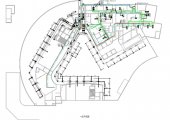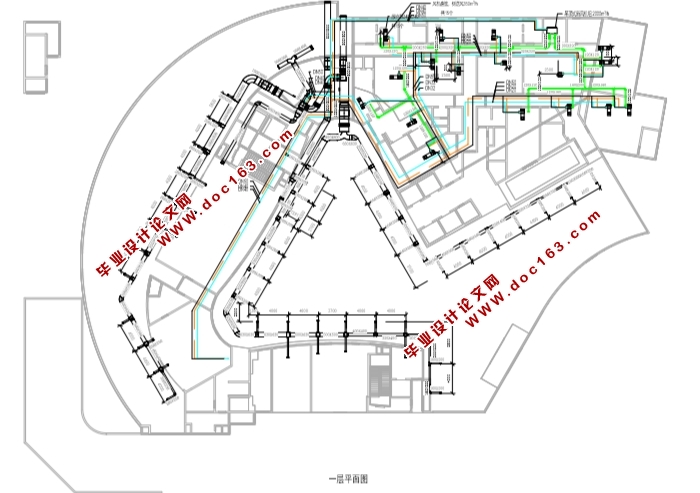南京市某酒店空调设计

南京市某酒店空调设计(任务书,开题报告,外文翻译,设计说明书18000字,PDF图11张)
摘要
本设计为南京市某酒店冷热源及空调系统设计,拟为之设计合理的空调系统,为室内人员提供舒适的工作环境。
在通过非稳态谐波反应法进行冷负荷的逐时计算,以及通过热面积指标法进行热负荷的计算的同时,以revit软件进行辅助计算。空调冷热源方案进行经济性比较,选用螺杆式水冷机组+(燃油)锅炉供热。空调风系统采用吊顶式风机盘管加吊顶式新风系统,以达到各个空调房间之间互不干扰,独立调节室内温湿度。空调水系统采用机械循环两管制一次泵定流量闭式系统,系统支管内大部分为异程布置,小部分为同程布置,支路间异程异程布置。空调区域及其他利用自然排风。建筑防排烟系统对地下一层、电梯前室和封闭的走廊、房间设置机械排烟,其余区域采用自然排烟。
本设计内容包括:空调冷热负荷计算:空调冷热源方案比较;空调风系统的选型及计算:空调水系统的选型及计算;水力计算;计:其他设备的选型;节能、保温与防腐以及减振和消声等内容。
关键字:冷热源,空调水系统,能耗
Air conditioning design of a Hotel in nanjing
Abstract
The design for a Hotel in nanjing cold and heat source and air conditioning system design, to design a reasonable air conditioning system for the indoor staff to provide a comfortable working environment.
[版权所有:http://DOC163.com]
The unsteady harmonic response method was used to calculate the cooling load hour by hour and the thermal area index method was used to calculate the heating load. Comparing the heat and cold source schemes of air conditioning, screw water cooling unit + (fuel)boiler is selected for heating. The air conditioning system adopts ceiling fan and roof type fresh air system, so that the air conditioning rooms dc rot interfere with each other.
independently adjust indoor temperature and humidity The water system of air conditioning adopts the closed system of mechanical circulation, two pipes and one pump: with fixed flow
Most of the branch pipes of the system are arranged differently a small part of them are arranged in the same way, and the branch roads are arranged differently. Air-conditioning area and other use of natural exhaust The smoke prevention and exhaust system of the building sets mechanical smoke exhaust on the first floor underground, elevator front room, closed corridor and room, and the rest areas adopt natural smoke exhaust.
This design includes: cold and heat load calculation of air conditioning: comparison of cold and heat source schemes of air conditioning;Selection and calculation of air conditioning system: selection and calculation of air conditioning water system; Hydraulic calculation;Computer: selection of other equipment; Energy saving, heat preservation and anticorrosion, vibration and noise reduction, etc.
Keywords:cold and heat source,air conditioning water system,energy consumption.
建筑概况
本设计位于南京市,酒店共十一层,包括两层裙楼,裙楼面积4000平方米,客房建筑面积9000平方米,所需设计空调面积近13000平方米。需进行制冷机房、空调、等设计。
1.2设计参数
1. 室外设计参数
指标 数值
夏季 大气压力(hPa) 1002.5
夏季通风室外计算温度(℃) 30.6
室外空调计算干球温度(℃) 34.8
室外空调计算湿球温度(℃) 28.1
[资料来源:Doc163.com]
空调室外计算日平均温度(℃) 65
空调室外计算相对湿度(%) 31.2
夏季室外风速(m/s) 2.4
冬季 大气压力(hPa) 1027.9
供暖室外计算温度(℃) -1.6
通风室外计算温度(℃) -1.1
室外空调计算温度(℃) -1.0
空调室外计算相对湿度(%) 79
冬季室外风速(m/s) 2.7
2.室内设计参数
根据GB50736-2012民用建筑供暖通风与空气调节设计规范3.0.2人员长期逗留区空调室内设计参数:
夏季 温度24℃-26℃ 相对湿度40-60%
冬季 温度22℃-24℃ 相对湿度≥30%1.3围护结构参数
[资料来源:https://www.doc163.com]


目录
第一章 设计概况 2
1.1建筑概况 2
1.2设计参数 2
1.3围护结构 2
1.4室内设计参数 5
1.5不同房间人均面积指标及照明负荷 6
第二章 负荷计算 6
2.1 通过围护结构传入的非稳态传热形成的逐时冷负荷 6
2.2 透过玻璃窗进入的太阳辐射得热形成的逐时冷负荷 7
2.3人体、照明和设备等散热形式的逐时冷负荷 7
2.4 人体散湿形成的潜热冷负荷 8
[资料来源:www.doc163.com]
2.5内墙、楼板等围护结构形成的冷负荷 8
2.6计算实例 8
2.4湿负荷的计算方法. 10
2.5热负荷计算 11
第三章 送风量确定及空调系统划分 14
3.1新风量计算 14
3.2风机盘管加新风系统 14
表3.1 风机盘管与新风连接方式的比较 15
第四章 设备选择 18
4.1风机盘管的选择 18
4.2新风机组的选择 18
第五章 气流组织的设计计算 18
5.1气流组织基本要求 18
5.2散流器送风 19
第六章、风系统设计计算 20
6.1风管设计的基本任务 20
6.2风管的选择 20
6.3风管水力计算 20
第七章、水系统设计计算 22
7.1空调水系统类型 22
7.2水力计算 23
7.3冷凝水管径的选择 33
第八章 制冷机房的设计计算 35
8.1.冷源的选择 35
8.2冷却塔设计计算 36
8.3分水器与集水器设计计算 37
8.4膨胀水箱配置与计算 38
8.5空调水系统管路的水力计算 38
8.6水泵计算 40
8.7热源的选择 41
8.8 锅炉型号及台数的选择 42
8.9燃气供应系统的设计 43
8.10水处理设备的选择 43
8.11 锅炉给水管路、循环水管路的水力计算 44
第九章 管道保温与防腐 46
9.1 保温 46
9.2防腐设计 47
第十章 空调系统的消声与隔振 48
10.1 噪声控制 48
10.2 振动控制 48
致谢 49
参考文献 50 [资料来源:www.doc163.com]
上一篇:南京某科研办公楼空调设计
下一篇:南京市大型商场空调设计
